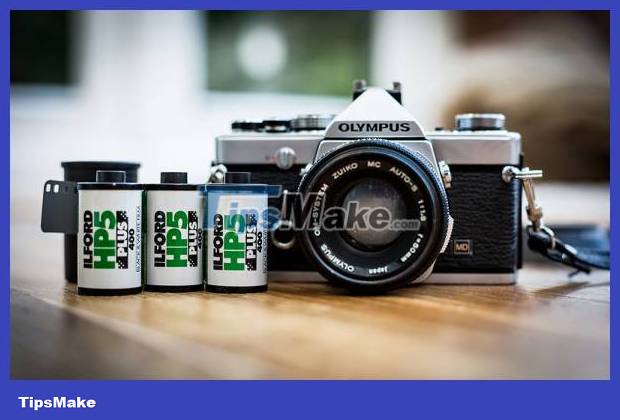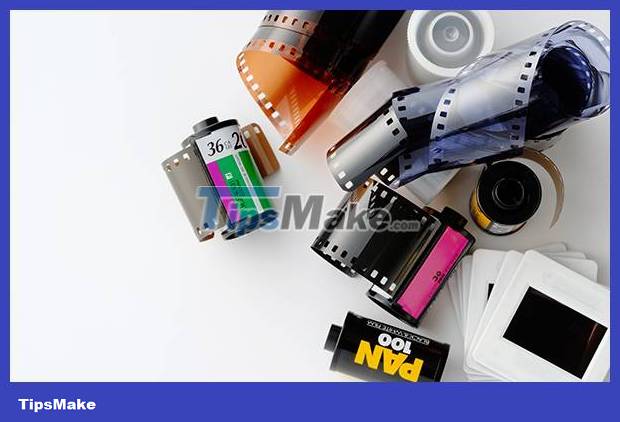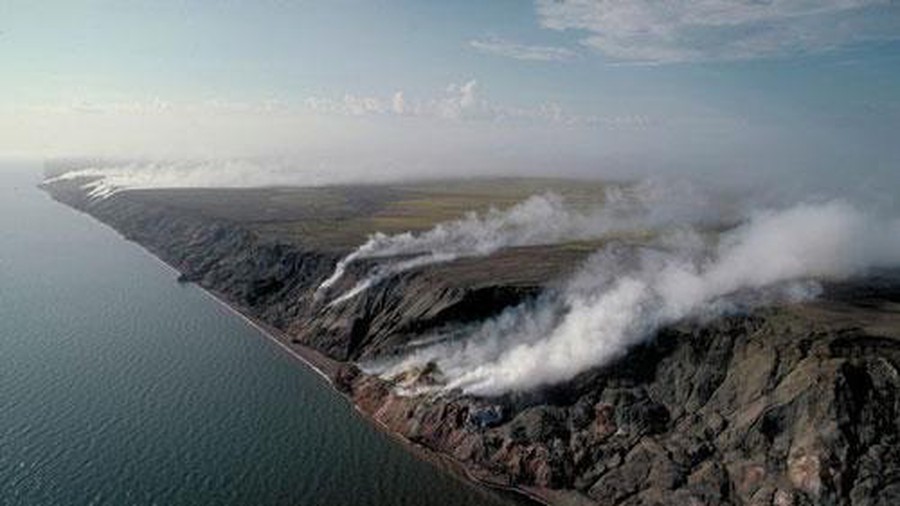All you need to know about film photography, an artistic hobby
Take a photo via digital camera and phone, then you have all the parameters of that photo and can quickly send it to friends, family via email, or post to social networking sites. Assembly and editing via software on phones or computers. However, if you are a photographer, you cannot help but know about analog photography, all photos taken will be like a magic show of light, using plastic film rolls and it takes time in days. even a month to be able to hold the photo in your hand.
Although professional photographers still use film cameras, they seem to have been abandoned the way we abandoned steam locomotives or public telephones. However, in the past year or two, the youth community has seen a movement to play movies, bringing vintage qualities into modern life. Let's learn more about how film photography works with TipsMake.com.
How does a film camera work?
Main features of film cameras:
- The case is made from plastic or metal, completely sealed, light cannot penetrate to protect the film roll.
- Aperture (or diaphragm): a small circular hole on the camera body that lets light in briefly when you press the shutter button.
- Shutter mechanism: imagine a set of blades overlapping each other in a circular shape, opening to draw in light and aperture for a precise time and then closing.
- One or more lenses in front of the shutter. Lenses are a very important part of a camera and each type of lens will take on many different tasks.
- A roll of film, placed in the rear film chamber, opposite the shutter.

How to take photos with a film camera
When you want to take a photo, you point the lens at the object, press the button and the shutter quickly opens, allowing light to pass through the aperture into the film, usually just a fraction of a second before the shutter closes. again.
Plastic film is very sensitive to light. Just a very small amount of light can cause the image to be overexposed, sometimes blown out. To create a perfect photo, you must accurately align the amount of light that will enter the film roll, which is the metering method. Metering depends on two factors: shutter speed and aperture opening. Shutter speed is measured in seconds (can range from 1/10,000 second to 30 seconds). Aperture has a separate unit called f-stops, for example f/4 and f/8. A smaller f number (like 1 or 2) means the aperture is wide open, allowing more light to enter; A higher f number (like 16, 22 or 32) means the opening is small, with less light coming in.

Automatic, pocket-sized or point-and-shoot cameras create well-exposed photos at the touch of a button. They use photocells (electronic light sensors), which automatically adjust shutter speed, aperture, and also autofocus. Although professional digital cameras now also have automatic modes, photographers still prefer to customize parameters manually. It represents creativity, capture and mastery of light sources. It's not for nothing that people say that photography is a way of playing with light.
Other features of film cameras
Most film cameras have a viewfinder (so you know what you're getting), a flash (for extra light in dark environments), and a timer (for taking photos yourself). yourself without anyone's help). Cheap cameras often have the viewfinder placed right above the main lens, so what you see through the lens is only roughly the same as the image taken. Professional cameras have a system called SLR (single lens reflex), in which prisms and mirrors allow you to look through the actual lens and see exactly what the resulting image will look like. Film cameras will not have an LCD screen to view photos after shooting like on modern digital cameras.
How does plastic film roll work?
Film is made from plastic (sometimes paper), covered with an emulsion made from silver salt crystals. This crystal is a compound of silver and halogens such as chlorine, iodine and bromine. This compound is said to turn into pure silver when exposed to light. This means, the more light it shines on, the more the film will change.

Film development process
A piece of plastic film with light printed on it cannot form an image. To turn them into the photos we still see today, you have to develop the film in a dark room (usually lit with blue or red lights so as not to affect the quality of the film). The process involves dipping the film into a chemical compound, turning the image made up of tiny silver salt crystals into a clear, permanent photograph.
Nowadays, technology is more developed, film can be developed in laboratories with many types of electronic machines, completing all processes automatically. They are like large scanners containing some chemical compounds. This color film development process is called C-41.
Types of films
Most films are rolled tightly in a plastic cover, protected from light, so that you can place them in the film chamber of your machine. Normally, a long roll of film will be divided into 12, 24 or 36 rectangular frames measuring 24mm x 36mm (this is a regular type of film, called 35mm film). The top and bottom edges are perforated with small holes to prevent the film from being torn when taking pictures, loading or recording the film.

There are also many types of film designed for many different photography purposes. Black and white film is extremely sensitive to light, the resulting image will only be black and white. Color film works just like black and white film, but some rolls are more sensitive to green, while some rolls are more sensitive to blue or red. Each type of film is also designed based on different lighting conditions. When shooting indoors or in dark light, you should choose fast film or conversely choose slow film if outdoors and good lighting conditions. Film speed is expressed by ISO number. ISO 100 is slow, 400 is fast and 200 is almost suitable for all situations.
You should read it
- How to take a 1998 film effect image on iPhone
- Download 1998 Cam, an old-fashioned animation and video capture app for iPhone, is now free
- 5 types of photos ideal for those who like to travel
- The harsh truths in photography
- The most basic things for new photographers
- How to Become a Film Producer
- 5 best free photography learning websites
- August 19: Celebrating 177 years of World Photography Day
May be interested
- The harsh truths in photography
 photography is a job that requires passion, talent, and experience to be drawn through photography. taking photos gives people joy and creativity when expressing their abilities in each photo.
photography is a job that requires passion, talent, and experience to be drawn through photography. taking photos gives people joy and creativity when expressing their abilities in each photo. - Incredible photos of the magic of motion
 photographers have captured many amazing scenes of people, animals and machines in various moving states in an artistic way with just a short click.
photographers have captured many amazing scenes of people, animals and machines in various moving states in an artistic way with just a short click. - The most basic things for new photographers
 photography is a very difficult field, not only holding up the camera and taking pictures are beautiful images will be released. here are the very essential things that beginners need to keep in mind.
photography is a very difficult field, not only holding up the camera and taking pictures are beautiful images will be released. here are the very essential things that beginners need to keep in mind. - How to Become a Film Producer
 if you want to get involved in making movies and see them from the beginning to the end, being a film producer may be the right career for you. a film producer assists creating a movie throughout the entire process, from sourcing scripts,...
if you want to get involved in making movies and see them from the beginning to the end, being a film producer may be the right career for you. a film producer assists creating a movie throughout the entire process, from sourcing scripts,... - 5 best free photography learning websites
 here are 5 best photography teaching websites, the teacher who teaches almost everything you need to get the best photo.
here are 5 best photography teaching websites, the teacher who teaches almost everything you need to get the best photo. - Beautiful photography tips on Samsung Galaxy A8
 with some photography tips on the samsung galaxy a8, we'll have unique artistic selfie shots.
with some photography tips on the samsung galaxy a8, we'll have unique artistic selfie shots. - August 19: Celebrating 177 years of World Photography Day
 august 19 is the day of world photography, the day to honor those who love photography. first held in france in 1893, this is an important milestone, marking the birth of the world photography industry.
august 19 is the day of world photography, the day to honor those who love photography. first held in france in 1893, this is an important milestone, marking the birth of the world photography industry. - Take a picture of the Cinematic Photography style
 cinematic photography is an entirely new type of cinematic photography. the photographer will do the color effect as well as adjust the aspect ratio to resemble the image taken from a movie.
cinematic photography is an entirely new type of cinematic photography. the photographer will do the color effect as well as adjust the aspect ratio to resemble the image taken from a movie. - 6 tips to help you take photos Selfie is more impressive
 taking photos selfie taking selfies is no longer a strange concept in today's digital age, especially for young people. by just owning a phone with the function of taking photos, you can have a photo of selfie for yourself. however, to take photos in a more artistic way, impressing more viewers, not everyone can do it. please refer to 6 tips that tipsmake.com share below.
taking photos selfie taking selfies is no longer a strange concept in today's digital age, especially for young people. by just owning a phone with the function of taking photos, you can have a photo of selfie for yourself. however, to take photos in a more artistic way, impressing more viewers, not everyone can do it. please refer to 6 tips that tipsmake.com share below. - 15 simple photography tips that help amateurs also become a professional photographer
 you are passionate about photography, but not economical enough to invest in professional photography equipment. so how to create beautiful pictures?
you are passionate about photography, but not economical enough to invest in professional photography equipment. so how to create beautiful pictures?










 Should I use a mount adapter for Mirrorless cameras?
Should I use a mount adapter for Mirrorless cameras? Top 8 best quality vintage photography apps on phones
Top 8 best quality vintage photography apps on phones 4 ways to transfer photos from computer to iPhone
4 ways to transfer photos from computer to iPhone Summary of 9+ ways to take screenshots of HP computers
Summary of 9+ ways to take screenshots of HP computers The mystery behind the self-fuming hills for centuries
The mystery behind the self-fuming hills for centuries She has the longest nose in the world
She has the longest nose in the world